Welcome to the division worksheets page at Math-Drills.com! Please give us your undivided attention while we introduce this page. Our worksheets for division help you to teach students the very important concept of division. If students have a good recall of multiplication facts, the division facts should be a breeze to teach. If you want your students to experience success in learning division, please make sure they know their multiplication facts to 81, how to multiply by 0 and how to multiply by 10. If they don't know these things, learning division will take a lot longer.
On this page you will find many Division Worksheets including division facts and long division with and without remainders. We start off with some division facts which are just the multiplication facts expressed in a different way. The main difference is that you can't divide by 0 and get a real number. If you really want your students to impress, say at their dinner table when their parents ask them what they learned today, you can teach them that division by zero is undefined.
The rest of the page is devoted to long division which for some reason is disliked among some members of the population. Long division is most difficult when students don't know their multiplication facts, so make sure they know them first! Oh, we already said that. What about a long division algorithm... maybe the one you or your parents or your grandparents learned? We adamantly say, yes! The reason that you and your ancestors used it is because it is an efficient and beautiful algorithm that will allow you to solve some of the most difficult division problems that even base ten blocks couldn't touch. It works equally well for decimals and whole numbers. Long division really isn't that hard.
Most Popular Division Worksheets this Week





Division Facts Tables
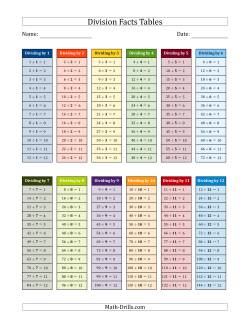
Like their counterparts on the multiplication facts page, these division facts tables can be used in a variety of ways to help students learn division facts. Students can memorize, look for patterns in the tables, compare them to multiplication tables, write answers on the versions with the answers omitted, or a variety of other learning activities. The tables come in gray, color and Montessori color depending on what fits you and your printer or school the best. For those that have already mastered the facts up to 12, they might be challenged to try the 13 to 24 versions.
-
Division Facts Tables in Gray 1 to 12 Division Facts Tables in Gray 1 to 12 (Answers Omitted) Division Facts Tables in Color 1 to 12 Division Facts Tables in Color 1 to 12 (Answers Omitted) Division Facts Tables in Color 1 to 12 with Individual Facts Highlighted Division Facts Tables in Montessori Colors 1 to 12 Division Facts Tables in Montessori Colors 1 to 12 (Answers Omitted)
Division Facts up to the 7 Times Table
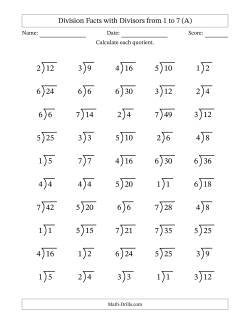
If your students aren't quite ready for all of the division facts at once, this might be a good place to start. Perhaps they are really good at the multiplying up to 5; there is a worksheet to help them practice, and when they are ready, they can include 6 then 7. This section includes vertical questions with the traditional division symbol (aka bracket) and some arranged with a division symbol like you might see addition, subtraction or multiplication arranged.
More worksheets with division facts up to 7, but these ones are arranged horizontally. This is a more natural arrangement for students who are used to reading things from left to right, allows them to practice recalling the answers and it is possible to fit 100 of these questions on the page without it getting too cluttered. If clutter is a problem though, there are also 50 and 25 question options.
Some students require chunking and more practice before they can handle the more complex pages with many different divisors. Here the worksheets only contain one divisor and there are several repetitions of the set on each page.
-
Vertically Arranged Dividing by 1 with Quotients 1 to 7 (50 Questions) ✎ Vertically Arranged Dividing by 2 with Quotients 1 to 7 (50 Questions) ✎ Vertically Arranged Dividing by 3 with Quotients 1 to 7 (50 Questions) ✎ Vertically Arranged Dividing by 4 with Quotients 1 to 7 (50 Questions) ✎ Vertically Arranged Dividing by 5 with Quotients 1 to 7 (50 Questions) ✎ Vertically Arranged Dividing by 6 with Quotients 1 to 7 (50 Questions) ✎ Vertically Arranged Dividing by 7 with Quotients 1 to 7 (50 Questions) ✎
More individual division facts worksheets but with a horizontal arrangement. This section includes 50 and 25 question options with each set repeated on the page.
-
Horizontally Arranged Dividing by 1 with Quotients 1 to 7 (50 Questions) ✎ Horizontally Arranged Dividing by 2 with Quotients 1 to 7 (50 Questions) ✎ Horizontally Arranged Dividing by 3 with Quotients 1 to 7 (50 Questions) ✎ Horizontally Arranged Dividing by 4 with Quotients 1 to 7 (50 Questions) ✎ Horizontally Arranged Dividing by 5 with Quotients 1 to 7 (50 Questions) ✎ Horizontally Arranged Dividing by 6 with Quotients 1 to 7 (50 Questions) ✎ Horizontally Arranged Dividing by 7 with Quotients 1 to 7 (50 Questions) ✎
-
Horizontally Arranged Dividing by 1 with Quotients 1 to 7 (25 Questions; Large Print) ✎ Horizontally Arranged Dividing by 2 with Quotients 1 to 7 (25 Questions; Large Print) ✎ Horizontally Arranged Dividing by 3 with Quotients 1 to 7 (25 Questions; Large Print) ✎ Horizontally Arranged Dividing by 4 with Quotients 1 to 7 (25 Questions; Large Print) ✎ Horizontally Arranged Dividing by 5 with Quotients 1 to 7 (25 Questions; Large Print) ✎ Horizontally Arranged Dividing by 6 with Quotients 1 to 7 (25 Questions; Large Print) ✎ Horizontally Arranged Dividing by 7 with Quotients 1 to 7 (25 Questions; Large Print) ✎
Division Facts up to the 9 Times Table
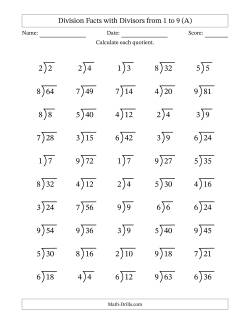
Manipulatives can help students "get" the concept of division. For example, students could regroup base ten blocks into units, then divide the units into piles. For the question 81 ÷ 9, students would start with eight ten blocks and one unit block. They would trade in the ten blocks for unit blocks and try to distribute all 81 of the unit blocks into nine piles. If they did it correctly, they would end up with 9 piles of 9 units and could say that 81 ÷ 9 = 9 as there are 9 units in each pile.
If students learn up to the 9 times table and can do all the related division, they are likely to do well in later math studies. Long multiplication and long division, algebra, and many other math topics rely on students knowing these facts. Division facts worksheets up to the nine times tables can be used for students to practice, as a diagnostic test to see what gaps exist, or as a mastery test before moving on to the next topic. This section includes horizontally arranged questions which allows for a 100 per page option. Worksheets up to the 8 times table are also included to ensure a continual flow with the rest of this page, say, if you were adding one number at a time.
More individual facts where a single number is used as the divisor throughout the entire worksheet. The quotients end up being in the range 1 to 9. These are great for students that need more practice on one or more divisors. This might be identified using a diagnostic test of a worksheet that includes all the division facts. If students consistently get questions wrong with a certain divisor, these worksheets might help them.
-
Vertically Arranged Dividing by 1 with Quotients 1 to 9 (50 Questions) ✎ Vertically Arranged Dividing by 2 with Quotients 1 to 9 (50 Questions) ✎ Vertically Arranged Dividing by 3 with Quotients 1 to 9 (50 Questions) ✎ Vertically Arranged Dividing by 4 with Quotients 1 to 9 (50 Questions) ✎ Vertically Arranged Dividing by 5 with Quotients 1 to 9 (50 Questions) ✎ Vertically Arranged Dividing by 6 with Quotients 1 to 9 (50 Questions) ✎ Vertically Arranged Dividing by 7 with Quotients 1 to 9 (50 Questions) ✎ Vertically Arranged Dividing by 8 with Quotients 1 to 9 (50 Questions) ✎ Vertically Arranged Dividing by 9 with Quotients 1 to 9 (50 Questions) ✎
Same as the previous section except with horizontally arranged questions and more options for the number of questions per page.
-
Horizontally Arranged Dividing by 1 with Quotients 1 to 9 (100 Questions) ✎ Horizontally Arranged Dividing by 2 with Quotients 1 to 9 (100 Questions) ✎ Horizontally Arranged Dividing by 3 with Quotients 1 to 9 (100 Questions) ✎ Horizontally Arranged Dividing by 4 with Quotients 1 to 9 (100 Questions) ✎ Horizontally Arranged Dividing by 5 with Quotients 1 to 9 (100 Questions) ✎ Horizontally Arranged Dividing by 6 with Quotients 1 to 9 (100 Questions) ✎ Horizontally Arranged Dividing by 7 with Quotients 1 to 9 (100 Questions) ✎ Horizontally Arranged Dividing by 8 with Quotients 1 to 9 (100 Questions) ✎ Horizontally Arranged Dividing by 9 with Quotients 1 to 9 (100 Questions) ✎
-
Horizontally Arranged Dividing by 1 with Quotients 1 to 9 (50 Questions) ✎ Horizontally Arranged Dividing by 2 with Quotients 1 to 9 (50 Questions) ✎ Horizontally Arranged Dividing by 3 with Quotients 1 to 9 (50 Questions) ✎ Horizontally Arranged Dividing by 4 with Quotients 1 to 9 (50 Questions) ✎ Horizontally Arranged Dividing by 5 with Quotients 1 to 9 (50 Questions) ✎ Horizontally Arranged Dividing by 6 with Quotients 1 to 9 (50 Questions) ✎ Horizontally Arranged Dividing by 7 with Quotients 1 to 9 (50 Questions) ✎ Horizontally Arranged Dividing by 8 with Quotients 1 to 9 (50 Questions) ✎ Horizontally Arranged Dividing by 9 with Quotients 1 to 9 (50 Questions) ✎
-
Horizontally Arranged Dividing by 1 with Quotients 1 to 9 (25 Questions; Large Print) ✎ Horizontally Arranged Dividing by 2 with Quotients 1 to 9 (25 Questions; Large Print) ✎ Horizontally Arranged Dividing by 3 with Quotients 1 to 9 (25 Questions; Large Print) ✎ Horizontally Arranged Dividing by 4 with Quotients 1 to 9 (25 Questions; Large Print) ✎ Horizontally Arranged Dividing by 5 with Quotients 1 to 9 (25 Questions; Large Print) ✎ Horizontally Arranged Dividing by 6 with Quotients 1 to 9 (25 Questions; Large Print) ✎ Horizontally Arranged Dividing by 7 with Quotients 1 to 9 (25 Questions; Large Print) ✎ Horizontally Arranged Dividing by 8 with Quotients 1 to 9 (25 Questions; Large Print) ✎ Horizontally Arranged Dividing by 9 with Quotients 1 to 9 (25 Questions; Large Print) ✎
Division Facts up to the 10 Times Table
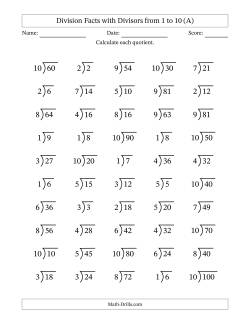
Ten is such an important number in math. Our entire numbering system is based on tens. There are ten digits and each lower place is a tenth (divided by 10) of the place before it. Although 10 is a two-digit number, it is almost always included in multiplication and division facts learning. Multiplying and dividing by 10 is so important there is a whole page (powers of ten) on Math-Drills dedicated to it.
If you jumped right to this section, you cannot be blamed! A lot of students learn their times tables all at once and that means including the most important 10! So, when they are ready for division worksheets, they are ready for this section. For students who might be struggling a bit though, please scroll up and start them off with something a little more at their pace.
Even with its size, 10 is often the easiest divisor to use... well, besides 1. This section includes horizontally arranged practice questions for all the division facts from the 1 times to the 10 times table.
The worksheets in this section are included for students that need the facts one at a time with quotients from 1 to 10.
-
Vertically Arranged Dividing by 1 with Quotients 1 to 10 (50 Questions) ✎ Vertically Arranged Dividing by 2 with Quotients 1 to 10 (50 Questions) ✎ Vertically Arranged Dividing by 3 with Quotients 1 to 10 (50 Questions) ✎ Vertically Arranged Dividing by 4 with Quotients 1 to 10 (50 Questions) ✎ Vertically Arranged Dividing by 5 with Quotients 1 to 10 (50 Questions) ✎ Vertically Arranged Dividing by 6 with Quotients 1 to 10 (50 Questions) ✎ Vertically Arranged Dividing by 7 with Quotients 1 to 10 (50 Questions) ✎ Vertically Arranged Dividing by 8 with Quotients 1 to 10 (50 Questions) ✎ Vertically Arranged Dividing by 9 with Quotients 1 to 10 (50 Questions) ✎ Vertically Arranged Dividing by 10 with Quotients 1 to 10 (50 Questions) ✎
A horizontal repeat of the previous section.
-
Horizontally Arranged Dividing by 1 with Quotients 1 to 10 (100 Questions) ✎ Horizontally Arranged Dividing by 2 with Quotients 1 to 10 (100 Questions) ✎ Horizontally Arranged Dividing by 3 with Quotients 1 to 10 (100 Questions) ✎ Horizontally Arranged Dividing by 4 with Quotients 1 to 10 (100 Questions) ✎ Horizontally Arranged Dividing by 5 with Quotients 1 to 10 (100 Questions) ✎ Horizontally Arranged Dividing by 6 with Quotients 1 to 10 (100 Questions) ✎ Horizontally Arranged Dividing by 7 with Quotients 1 to 10 (100 Questions) ✎ Horizontally Arranged Dividing by 8 with Quotients 1 to 10 (100 Questions) ✎ Horizontally Arranged Dividing by 9 with Quotients 1 to 10 (100 Questions) ✎ Horizontally Arranged Dividing by 10 with Quotients 1 to 10 (100 Questions) ✎
-
Horizontally Arranged Dividing by 1 with Quotients 1 to 10 (50 Questions) ✎ Horizontally Arranged Dividing by 2 with Quotients 1 to 10 (50 Questions) ✎ Horizontally Arranged Dividing by 3 with Quotients 1 to 10 (50 Questions) ✎ Horizontally Arranged Dividing by 4 with Quotients 1 to 10 (50 Questions) ✎ Horizontally Arranged Dividing by 5 with Quotients 1 to 10 (50 Questions) ✎ Horizontally Arranged Dividing by 6 with Quotients 1 to 10 (50 Questions) ✎ Horizontally Arranged Dividing by 7 with Quotients 1 to 10 (50 Questions) ✎ Horizontally Arranged Dividing by 8 with Quotients 1 to 10 (50 Questions) ✎ Horizontally Arranged Dividing by 9 with Quotients 1 to 10 (50 Questions) ✎ Horizontally Arranged Dividing by 10 with Quotients 1 to 10 (50 Questions) ✎
-
Horizontally Arranged Dividing by 1 with Quotients 1 to 10 (25 Questions; Large Print) ✎ Horizontally Arranged Dividing by 2 with Quotients 1 to 10 (25 Questions; Large Print) ✎ Horizontally Arranged Dividing by 3 with Quotients 1 to 10 (25 Questions; Large Print) ✎ Horizontally Arranged Dividing by 4 with Quotients 1 to 10 (25 Questions; Large Print) ✎ Horizontally Arranged Dividing by 5 with Quotients 1 to 10 (25 Questions; Large Print) ✎ Horizontally Arranged Dividing by 6 with Quotients 1 to 10 (25 Questions; Large Print) ✎ Horizontally Arranged Dividing by 7 with Quotients 1 to 10 (25 Questions; Large Print) ✎ Horizontally Arranged Dividing by 8 with Quotients 1 to 10 (25 Questions; Large Print) ✎ Horizontally Arranged Dividing by 9 with Quotients 1 to 10 (25 Questions; Large Print) ✎ Horizontally Arranged Dividing by 10 with Quotients 1 to 10 (25 Questions; Large Print) ✎
Division Facts up to the 12 Times Table
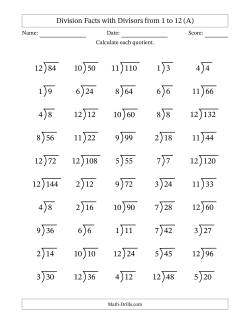
Ah, twelve. Educators have a penchant for the the 12 times table likely because it is important in clocks, eggs, the Vendergood language, and definitely to the Dozenal Societies of America and Great Britain. In mathematics, it is seen mostly in the completion of both multiplication and division facts worksheets. Since Math-Drills is happy to support the base twelve system, we present worksheets with division facts up to the 12 times table in the unlikely event that the duodecimal (aka dozenal) system is ever adopted.
Division is essentially asking the question, "How many _____'s are in _____?" For the question, 81 ÷ 9, the prompt would sound like, "How many 9's are in 81?" This prompt will benefit students in later math studies when there are more complex concepts such as dividing decimals or fractions. "How many thirds are in four?" or even better, "How many third cups are in four cups?" If necessary, get out the measuring cups.
This important section includes worksheets with division facts up to the 12 times table with a 100 question option.
So, if you are having your students learn division facts up to the 12 times table, it might be useful to have some worksheets with individual facts for a few students who might be overwhelmed with everything at once!
-
Vertically Arranged Dividing by 1 with Quotients 1 to 12 (50 Questions) ✎ Vertically Arranged Dividing by 2 with Quotients 1 to 12 (50 Questions) ✎ Vertically Arranged Dividing by 3 with Quotients 1 to 12 (50 Questions) ✎ Vertically Arranged Dividing by 4 with Quotients 1 to 12 (50 Questions) ✎ Vertically Arranged Dividing by 5 with Quotients 1 to 12 (50 Questions) ✎ Vertically Arranged Dividing by 6 with Quotients 1 to 12 (50 Questions) ✎ Vertically Arranged Dividing by 7 with Quotients 1 to 12 (50 Questions) ✎ Vertically Arranged Dividing by 8 with Quotients 1 to 12 (50 Questions) ✎ Vertically Arranged Dividing by 9 with Quotients 1 to 12 (50 Questions) ✎ Vertically Arranged Dividing by 10 with Quotients 1 to 12 (50 Questions) ✎ Vertically Arranged Dividing by 11 with Quotients 1 to 12 (50 Questions) ✎ Vertically Arranged Dividing by 12 with Quotients 1 to 12 (50 Questions) ✎
-
Vertically Arranged Dividing by 1, 2, 5 and 10 with Quotients 1 to 12 (50 Questions) ✎ Vertically Arranged Dividing by 3, 4 and 6 with Quotients 1 to 12 (50 Questions) ✎ Vertically Arranged Dividing by 7, 8 and 9 with Quotients 1 to 12 (50 Questions) ✎ Vertically Arranged Dividing by 11 and 12 with Quotients 1 to 12 (50 Questions) ✎
Same idea as the previous section, but with a horizontal arrangement and different numbers of questions on each page.
-
Horizontally Arranged Dividing by 1 with Quotients 1 to 12 (100 Questions) ✎ Horizontally Arranged Dividing by 2 with Quotients 1 to 12 (100 Questions) ✎ Horizontally Arranged Dividing by 3 with Quotients 1 to 12 (100 Questions) ✎ Horizontally Arranged Dividing by 4 with Quotients 1 to 12 (100 Questions) ✎ Horizontally Arranged Dividing by 5 with Quotients 1 to 12 (100 Questions) ✎ Horizontally Arranged Dividing by 6 with Quotients 1 to 12 (100 Questions) ✎ Horizontally Arranged Dividing by 7 with Quotients 1 to 12 (100 Questions) ✎ Horizontally Arranged Dividing by 8 with Quotients 1 to 12 (100 Questions) ✎ Horizontally Arranged Dividing by 9 with Quotients 1 to 12 (100 Questions) ✎ Horizontally Arranged Dividing by 10 with Quotients 1 to 12 (100 Questions) ✎ Horizontally Arranged Dividing by 11 with Quotients 1 to 12 (100 Questions) ✎ Horizontally Arranged Dividing by 12 with Quotients 1 to 12 (100 Questions) ✎
-
Horizontally Arranged Dividing by 1 with Quotients 1 to 12 (50 Questions) ✎ Horizontally Arranged Dividing by 2 with Quotients 1 to 12 (50 Questions) ✎ Horizontally Arranged Dividing by 3 with Quotients 1 to 12 (50 Questions) ✎ Horizontally Arranged Dividing by 4 with Quotients 1 to 12 (50 Questions) ✎ Horizontally Arranged Dividing by 5 with Quotients 1 to 12 (50 Questions) ✎ Horizontally Arranged Dividing by 6 with Quotients 1 to 12 (50 Questions) ✎ Horizontally Arranged Dividing by 7 with Quotients 1 to 12 (50 Questions) ✎ Horizontally Arranged Dividing by 8 with Quotients 1 to 12 (50 Questions) ✎ Horizontally Arranged Dividing by 9 with Quotients 1 to 12 (50 Questions) ✎ Horizontally Arranged Dividing by 10 with Quotients 1 to 12 (50 Questions) ✎ Horizontally Arranged Dividing by 11 with Quotients 1 to 12 (50 Questions) ✎ Horizontally Arranged Dividing by 12 with Quotients 1 to 12 (50 Questions) ✎
-
Horizontally Arranged Dividing by 1 with Quotients 1 to 12 (25 Questions; Large Print) ✎ Horizontally Arranged Dividing by 2 with Quotients 1 to 12 (25 Questions; Large Print) ✎ Horizontally Arranged Dividing by 3 with Quotients 1 to 12 (25 Questions; Large Print) ✎ Horizontally Arranged Dividing by 4 with Quotients 1 to 12 (25 Questions; Large Print) ✎ Horizontally Arranged Dividing by 5 with Quotients 1 to 12 (25 Questions; Large Print) ✎ Horizontally Arranged Dividing by 6 with Quotients 1 to 12 (25 Questions; Large Print) ✎ Horizontally Arranged Dividing by 7 with Quotients 1 to 12 (25 Questions; Large Print) ✎ Horizontally Arranged Dividing by 8 with Quotients 1 to 12 (25 Questions; Large Print) ✎ Horizontally Arranged Dividing by 9 with Quotients 1 to 12 (25 Questions; Large Print) ✎ Horizontally Arranged Dividing by 10 with Quotients 1 to 12 (25 Questions; Large Print) ✎ Horizontally Arranged Dividing by 11 with Quotients 1 to 12 (25 Questions; Large Print) ✎ Horizontally Arranged Dividing by 12 with Quotients 1 to 12 (25 Questions; Large Print) ✎
Division Facts beyond the 12 Times Table
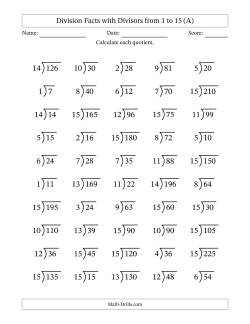
Scenario: you have some students that have aced the division facts up to the 12 times table and need more of a challenge. This section has got you covered. Is there an argument for learning division facts for times tables beyond 9? 10? 12? Sure, why not. Students are likely to apply their knowledge in future math studies by instantly recognizing that the square root of 625 is 25, for example.
-
Vertical Division Facts Up To the 13 Times Table With Long Division Symbol/Bracket (50 per page) ✎ Vertical Division Facts Up To the 14 Times Table With Long Division Symbol/Bracket (50 per page) ✎ Vertical Division Facts Up To the 15 Times Table With Long Division Symbol/Bracket (50 per page) ✎ Vertical Division Facts Up To the 16 Times Table With Long Division Symbol/Bracket (50 per page) ✎ Vertical Division Facts Up To the 17 Times Table With Long Division Symbol/Bracket (50 per page) ✎ Vertical Division Facts Up To the 18 Times Table With Long Division Symbol/Bracket (50 per page) ✎ Vertical Division Facts Up To the 19 Times Table With Long Division Symbol/Bracket (50 per page) ✎ Vertical Division Facts Up To the 20 Times Table With Long Division Symbol/Bracket (50 per page) ✎ Vertical Division Facts From 5 Up To the 21 Times Table With Long Division Symbol/Bracket (50 per page) ✎ Vertical Division Facts From 5 Up To the 22 Times Table With Long Division Symbol/Bracket (50 per page) ✎ Vertical Division Facts From 5 Up To the 23 Times Table With Long Division Symbol/Bracket (50 per page) ✎ Vertical Division Facts From 5 Up To the 24 Times Table With Long Division Symbol/Bracket (50 per page) ✎ Vertical Division Facts From 5 Up To the 25 Times Table With Long Division Symbol/Bracket (50 per page) ✎
There are certainly a few questions on these worksheets that will be useful knowledge later on. If your students are interested in learning them, anything to do with 16, 20, 24, and 25 will certainly be useful, and likely someone could come up with a reason for learning the others. Sixteen is used in the base 16 (aka hexadecimal system), so converting hexadecimal numbers to decimal numbers involves dividing (and multiplying by 16). Twenty is a great number that is divisible by six different numbers and in turn is a factor of some important numbers. Twenty is also a coin unit in many countries. Twenty-four hours is the length of a day, so if you wanted to know how many days were in 288 hours, you might want to know your 24 times table division facts. Twenty-five, well that is the value of a quarter, isn't it? You could also calculate how many seconds of PAL video you have by dividing the number of frames by 25!
-
Horizontally Arranged Division Facts Up to the 13 Times Table (100 Questions) ✎ Horizontally Arranged Division Facts Up to the 14 Times Table (100 Questions) ✎ Horizontally Arranged Division Facts Up to the 15 Times Table (100 Questions) ✎ Horizontally Arranged Division Facts Up to the 16 Times Table (100 Questions) ✎ Horizontally Arranged Division Facts Up to the 17 Times Table (100 Questions) ✎ Horizontally Arranged Division Facts Up to the 18 Times Table (100 Questions) ✎ Horizontally Arranged Division Facts Up to the 19 Times Table (100 Questions) ✎ Horizontally Arranged Division Facts Up to the 20 Times Table (100 Questions) ✎
If the previous two sections are a little tough to handle right out of the gates, perhaps start with these worksheets that only deal with one of the divisors at a time.
-
Vertically Arranged Dividing by 13 with Quotients 1 to 13 (50 Questions) ✎ Vertically Arranged Dividing by 14 with Quotients 1 to 14 (50 Questions) ✎ Vertically Arranged Dividing by 15 with Quotients 1 to 15 (50 Questions) ✎ Vertically Arranged Dividing by 16 with Quotients 1 to 16 (50 Questions) ✎ Vertically Arranged Dividing by 17 with Quotients 1 to 17 (50 Questions) ✎ Vertically Arranged Dividing by 18 with Quotients 1 to 18 (50 Questions) ✎ Vertically Arranged Dividing by 19 with Quotients 1 to 19 (50 Questions) ✎ Vertically Arranged Dividing by 20 with Quotients 1 to 20 (50 Questions) ✎ Vertically Arranged Dividing by 21 with Quotients 1 to 21 (50 Questions) ✎ Vertically Arranged Dividing by 22 with Quotients 1 to 22 (50 Questions) ✎ Vertically Arranged Dividing by 23 with Quotients 1 to 23 (50 Questions) ✎ Vertically Arranged Dividing by 24 with Quotients 1 to 24 (50 Questions) ✎ Vertically Arranged Dividing by 25 with Quotients 1 to 25 (50 Questions) ✎
Even more of the previous section, but with 100 questions per page and a horizonal arrangement.
-
Horizontally Arranged Dividing by 13 with Quotients 1 to 13 (100 Questions) ✎ Horizontally Arranged Dividing by 14 with Quotients 1 to 14 (100 Questions) ✎ Horizontally Arranged Dividing by 15 with Quotients 1 to 15 (100 Questions) ✎ Horizontally Arranged Dividing by 16 with Quotients 1 to 16 (100 Questions) ✎ Horizontally Arranged Dividing by 17 with Quotients 1 to 17 (100 Questions) ✎ Horizontally Arranged Dividing by 18 with Quotients 1 to 18 (100 Questions) ✎ Horizontally Arranged Dividing by 19 with Quotients 1 to 19 (100 Questions) ✎ Horizontally Arranged Dividing by 20 with Quotients 1 to 20 (100 Questions) ✎ Horizontally Arranged Dividing by 21 with Quotients 1 to 21 (100 Questions) ✎ Horizontally Arranged Dividing by 22 with Quotients 1 to 22 (100 Questions) ✎ Horizontally Arranged Dividing by 23 with Quotients 1 to 23 (100 Questions) ✎ Horizontally Arranged Dividing by 24 with Quotients 1 to 24 (100 Questions) ✎ Horizontally Arranged Dividing by 25 with Quotients 1 to 25 (100 Questions) ✎
Long division Worksheets
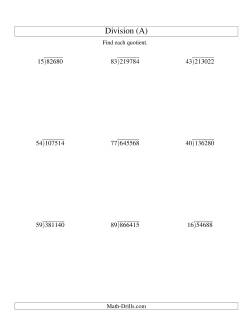
Need an easier way to divide large numbers? Try this method using powers of ten. To successfully use this method, students need to be able to multiply by powers of ten and to subtract. Students subtract the dividend multiplied by decreasing powers of ten until they have zero or a remainder. Example: 1458 ÷ 54. Note 54 × 1 = 54, 54 × 10 = 540 (nothing greater is needed). 1458 - 540 - 540 = 378. Note that 540 was subtracted twice, so the number of times that 54 "goes into" 1458 so far is 20 times. Continuing, 378 - 54 - 54 - 54 - 54 - 54 - 54 - 54 = 0. Since 54 was subtracted seven times, the quotient increases by seven for a total of 27. In other words, 54 "goes into" 1458, 27 times.
We might also mention that this method can be even more sophisticated by using multiples of powers of ten. In the above example, using 54 × 5 = 270 would have helped to get to the quotient quicker.
-
Long Division with No Remainders with a Multiple of Ten Divisor and a 2-Digit Quotient Long Division with No Remainders with a 1-Digit Divisor and a 1-Digit Quotient Long Division with No Remainders with a 1-Digit Divisor and a 2-Digit Quotient Long Division with No Remainders with a 1-Digit Divisor and a 3-Digit Quotient Long Division with No Remainders with a 2-Digit Divisor and a 2-Digit Quotient Long Division with No Remainders with a 2-Digit Divisor and a 3-Digit Quotient Long Division with No Remainders with a 2-Digit Divisor and a 4-Digit Quotient Long Division with No Remainders with a 3-Digit Divisor and a 3-Digit Quotient Long Division with No Remainders with a 3-Digit Divisor and a 4-Digit Quotient Long Division with No Remainders with a 3-Digit Divisor and a 5-Digit Quotient
-
European Format Long Division with No Remainders with a 1-Digit Divisor and a 1-Digit Quotient European Format Long Division with No Remainders with a 1-Digit Divisor and a 2-Digit Quotient European Format Long Division with No Remainders with a 1-Digit Divisor and a 3-Digit Quotient European Format Long Division with No Remainders with a 2-Digit Divisor and a 2-Digit Quotient European Format Long Division with No Remainders with a 2-Digit Divisor and a 3-Digit Quotient European Format Long Division with No Remainders with a 2-Digit Divisor and a 4-Digit Quotient European Format Long Division with No Remainders with a 3-Digit Divisor and a 2-Digit Quotient European Format Long Division with No Remainders with a 3-Digit Divisor and a 3-Digit Quotient European Format Long Division with No Remainders with a 3-Digit Divisor and a 4-Digit Quotient
Have you ever thought that you could help a student understand things better and get a more precise answer while still using remainders? It's quite easy really. Remainders are usually given out of context, including on the answer keys below. A remainder is really a numerator in a fractional quotient. For example 19 ÷ 3 is 6 with a remainder of 1 which is more precisely 6 1/3. Using fractional quotients means your students will always find the exact answer to all long division questions, and in many cases the answer will actually be more precise (e.g. compare 6 1/3 with 6.3333....).
-
Long Division with Remainders with a Multiple of Ten Divisor and a 2-Digit Quotient Long Division with Remainders with a 1-Digit Divisor and a 2-Digit Dividend Long Division with Remainders with a 1-Digit Divisor and a 3-Digit Dividend Long Division with Remainders with a 1-Digit Divisor and a 4-Digit Dividend Long Division with Remainders with a 2-Digit Divisor and a 3-Digit Dividend Long Division with Remainders with a 2-Digit Divisor and a 4-Digit Dividend Long Division with Remainders with a 2-Digit Divisor and a 5-Digit Dividend Long Division with Remainders with a 3-Digit Divisor and a 4-Digit Dividend Long Division with Remainders with a 3-Digit Divisor and a 5-Digit Dividend Long Division with Remainders with a 3-Digit Divisor and a 6-Digit Dividend
-
European Format Long Division with Remainders with a 1-Digit Divisor and a 2-Digit Dividend European Format Long Division with Remainders with a 1-Digit Divisor and a 3-Digit Dividend European Format Long Division with Remainders with a 1-Digit Divisor and a 4-Digit Dividend European Format Long Division with Remainders with a 2-Digit Divisor and a 3-Digit Dividend European Format Long Division with Remainders with a 2-Digit Divisor and a 4-Digit Dividend European Format Long Division with Remainders with a 2-Digit Divisor and a 5-Digit Dividend European Format Long Division with Remainders with a 3-Digit Divisor and a 4-Digit Dividend European Format Long Division with Remainders with a 3-Digit Divisor and a 5-Digit Dividend European Format Long Division with Remainders with a 3-Digit Divisor and a 6-Digit Dividend
-
Long Division with Decimal Quotients with a 1-Digit Divisor; 2-Digit Dividend Long Division with Decimal Quotients with a 1-Digit Divisor; 3-Digit Dividend Long Division with Decimal Quotients with a 1-Digit Divisor; 4-Digit Dividend Long Division with Decimal Quotients with a 2-Digit Divisor; 3-Digit Dividend Long Division with Decimal Quotients with a 2-Digit Divisor; 4-Digit Dividend Long Division with Decimal Quotients with a 2-Digit Divisor; 5-Digit Dividend Long Division with Decimal Quotients with a 3-Digit Divisor; 4-Digit Dividend Long Division with Decimal Quotients with a 3-Digit Divisor; 5-Digit Dividend Long Division with Decimal Quotients with a 3-Digit Divisor; 6-Digit Dividend
-
European Format Long Division with Decimal Quotients with a 1-Digit Divisor; 2-Digit Dividend European Format Long Division with Decimal Quotients with a 1-Digit Divisor; 3-Digit Dividend European Format Long Division with Decimal Quotients with a 2-Digit Divisor; 2-Digit Dividend European Format Long Division with Decimal Quotients with a 2-Digit Divisor; 3-Digit Dividend European Format Long Division with Decimal Quotients with a 2-Digit Divisor; 4-Digit Dividend European Format Long Division with Decimal Quotients with a 3-Digit Divisor; 3-Digit Dividend European Format Long Division with Decimal Quotients with a 3-Digit Divisor; 4-Digit Dividend European Format Long Division with Decimal Quotients with a 3-Digit Divisor; 5-Digit Dividend
We thought it might be helpful to include some long division worksheets with the steps shown. The answer keys for these division worksheets use the standard algorithm that you might learn if you went to an English speaking school. Learning this algorithm by itself is sometimes not enough as it may not lead to a good conceptual understanding. One tool that helps students learn the standard algorithm and develop an understanding of division is a set of base ten blocks. By teaching students division with base ten blocks first then progressing to the standard algorithm, students will gain a conceptual understanding plus have the use of an efficient algorithm for long division. Students who have both of these things will naturally experience more success in their future mathematical studies.
-
2-Digit by 1-Digit Long Division with Remainders with the Steps Shown on the Answer Key 3-Digit by 1-Digit Long Division with Remainders with the Steps Shown on the Answer Key 4-Digit by 1-Digit Long Division with Remainders with the Steps Shown on the Answer Key 5-Digit by 1-Digit Long Division with Remainders with the Steps Shown on the Answer Key 6-Digit by 1-Digit Long Division with Remainders with the Steps Shown on the Answer Key
-
3-Digit by 2-Digit Long Division with Remainders with the Steps Shown on the Answer Key 4-Digit by 2-Digit Long Division with Remainders with the Steps Shown on the Answer Key 5-Digit by 2-Digit Long Division with Remainders with the Steps Shown on the Answer Key 6-Digit by 2-Digit Long Division with Remainders with the Steps Shown on the Answer Key
Some students find it difficult to get everything lined up when completing a long division algorithm, so these worksheets include a grid and wider spacing of the digits to help students get things in the right place. The answer keys include the typical steps that students would record while completing each problem; however, slight variations in implementation may occur. For example, some people don't bother with the subtraction signs,some might show steps subtracting zero, etc.
-
2-Digit by 1-Digit Long Division with Grid Assistance and Prompts and NO Remainders 3-Digit by 1-Digit Long Division with Grid Assistance and Prompts and NO Remainders 3-Digit by 2-Digit Long Division with Grid Assistance and Prompts and NO Remainders 4-Digit by 1-Digit Long Division with Grid Assistance and Prompts and NO Remainders 4-Digit by 2-Digit Long Division with Grid Assistance and Prompts and NO Remainders 5-Digit by 1-Digit Long Division with Grid Assistance and Prompts and NO Remainders 5-Digit by 2-Digit Long Division with Grid Assistance and Prompts and NO Remainders 6-Digit by 1-Digit Long Division with Grid Assistance and Prompts and NO Remainders 6-Digit by 2-Digit Long Division with Grid Assistance and Prompts and NO Remainders
-
3-Digit by 1-Digit Long Division with Grid Assistance and NO Remainders 3-Digit by 2-Digit Long Division with Grid Assistance and NO Remainders 4-Digit by 1-Digit Long Division with Grid Assistance and NO Remainders 4-Digit by 2-Digit Long Division with Grid Assistance and NO Remainders 5-Digit by 1-Digit Long Division with Grid Assistance and NO Remainders 5-Digit by 2-Digit Long Division with Grid Assistance and NO Remainders 6-Digit by 1-Digit Long Division with Grid Assistance and NO Remainders 6-Digit by 2-Digit Long Division with Grid Assistance and NO Remainders
-
2-Digit by 1-Digit Long Division with Grid Assistance and Prompts and some Remainders 3-Digit by 1-Digit Long Division with Grid Assistance and Prompts and some Remainders 3-Digit by 2-Digit Long Division with Grid Assistance and Prompts and some Remainders 4-Digit by 1-Digit Long Division with Grid Assistance and Prompts and some Remainders 4-Digit by 2-Digit Long Division with Grid Assistance and Prompts and some Remainders 5-Digit by 1-Digit Long Division with Grid Assistance and Prompts and some Remainders 5-Digit by 2-Digit Long Division with Grid Assistance and Prompts and some Remainders 6-Digit by 1-Digit Long Division with Grid Assistance and Prompts and some Remainders 6-Digit by 2-Digit Long Division with Grid Assistance and Prompts and some Remainders
-
3-Digit by 1-Digit Long Division with Grid Assistance and some Remainders 3-Digit by 2-Digit Long Division with Grid Assistance and some Remainders 4-Digit by 1-Digit Long Division with Grid Assistance and some Remainders 4-Digit by 2-Digit Long Division with Grid Assistance and some Remainders 5-Digit by 1-Digit Long Division with Grid Assistance and some Remainders 5-Digit by 2-Digit Long Division with Grid Assistance and some Remainders 6-Digit by 1-Digit Long Division with Grid Assistance and some Remainders 6-Digit by 2-Digit Long Division with Grid Assistance and some Remainders
Divisibility by 2, 5 and 10
A number is divisible by 2 if the final digit (the digit in the ones place) is even. Numbers ending in 0, 2, 4, 6, or 8 therefore are divisible by 2. A number is divisible by 5 if the final digit is a 0 or a 5. A number is divisible by 10 if the final digit is a 0.
Divisibility by 3, 6 and 9
A number is divisible by 3 if the sum of its digits is divisible by 3. For example, 285 is divisible by 3 because 2 + 8 + 5 = 15 is divisible by 3. A number is divisible by 6 if it is divisible by both 3 and 2 (see above rules). A number is divisible by 9 if the sum of its digits is divisible by 9. For examples, 285 is not divisible by 9 because 2 + 8 + 5 = 15 is not divisible by 9.
Divisibility by 4, 7 and 8
A number is divisible by 4 if the last two digits of the number are divisible by 4. For 7, there are a couple of strategies to use. Please see Divisibility Tricks for Learning Math for more information. A number is divisible by 8 if the last three digits are divisible by 8. This is the standard rule which can be a little sketchy for larger numbers, like who knows if 680 is divisible by 8? Because of this, we offer our Math-Drills.com solution which requires a little arithmetic, but can be accomplished quite easily with a little practice. As you know 8 is 2 to the third power, so we thought if you could divide the last three digits of a number by 2 three times, it would be divisible by 8. 680 ÷ 2 ÷ 2 ÷ 2 = 340 ÷ 2 ÷ 2 = 170 ÷ 2 = 85. We have a winner! 680 is indeed divisible by 8.
Dividing numbers in number systems other than decimal numbers including binary, quaternary, octal, duodecimal and hexadecimal numbers.
-
Dividing Binary Numbers (Base 2) Dividing Ternary Numbers (Base 3) Dividing Quaternary Numbers (Base 4) Dividing Quinary Numbers (Base 5) Dividing Senary Numbers (Base 6) Dividing Octal Numbers (Base 8) Dividing Duodecimal Numbers (Base 12) Dividing Hexadecimal Numbers (Base 16) Dividing Vigesimal Numbers (Base 20) Dividing Hexatrigesimal Numbers (Base 36) Dividing Various Numbers (Various Bases)
